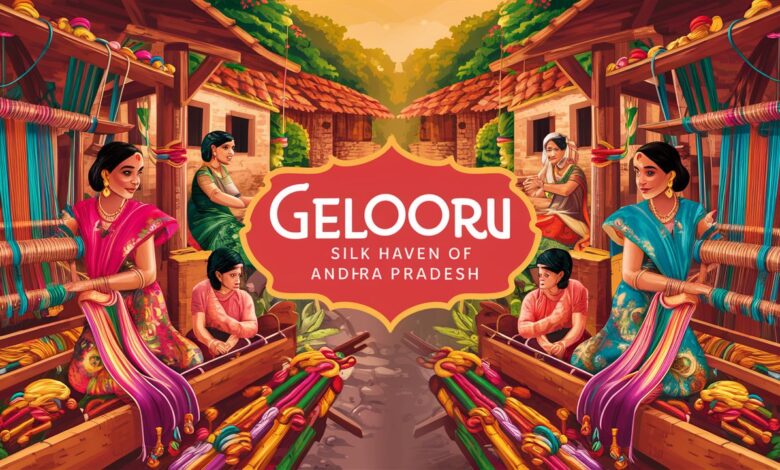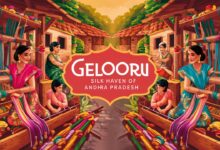Gel Ooru: The Silk Haven of Andhra Pradesh – Weaving Tradition, Culture, and Heritage

Nestled in the heart of Andhra Pradesh, Gel Ooru (also known as Gollaprolu) is a village synonymous with the timeless craft of silk weaving. Renowned for its exquisite handloom silk sarees, this humble village is a living testament to India’s rich textile heritage. For centuries, generations of weavers here have meticulously transformed golden threads into luxurious fabrics, blending artistry with tradition. Beyond its silken treasures, Gel Ooru is a cultural microcosm where festivals, rituals, and daily life revolve around the rhythmic clatter of looms. This article explores the village’s historical roots, craftsmanship, challenges, and enduring legacy, offering a deep dive into why Gel Ooru is celebrated as a beacon of India’s handloom industry.
The Historical Roots of Gel Ooru
Gel Ooru’s history is intertwined with the rise of silk weaving in South India. Historical records suggest the village’s weaving traditions date back to the 16th century, when local artisans began mastering the art of silk under the patronage of regional rulers. The fertile lands of Andhra Pradesh provided ample mulberry cultivation, essential for sericulture, while the Krishna River’s proximity facilitated trade. Over time, Gel Ooru evolved into a hub for high-quality silk, attracting merchants from across the subcontinent. Today, ancient temples and weathered looms stand as silent witnesses to this legacy, preserving stories of resilience and creativity passed down through generations.
The Art of Silk Weaving: A Symphony of Skill and Precision
At the heart of Gel Ooru’s fame lies its silk weaving process, a labor-intensive craft requiring unparalleled skill. Artisans begin by dyeing raw silk threads in vibrant hues, often using natural dyes derived from plants and minerals. These threads are then carefully arranged on traditional wooden looms, where weavers spend weeks—sometimes months—interlacing them into intricate patterns. The signature Gel Ooru saree features elaborate zari (gold thread) work, floral motifs, and bold borders, reflecting a blend of Mughal and South Indian influences. Each saree is a masterpiece, embodying the weaver’s dedication and an artistic lineage spanning centuries.
The Handloom Industry: Economic Backbone of the Village
The handloom industry is the lifeblood of Gel Ooru, employing over 70% of its population. Families often work collectively, with men operating looms and women handling spinning and dyeing. The village’s economy thrives on both domestic sales and exports, with sarees shipped to markets in Mumbai, Delhi, and even overseas. However, the industry faces challenges from power looms and synthetic fabrics, which threaten to overshadow handwoven silk’s uniqueness. Despite this, Gel Ooru’s weavers remain committed to preserving their craft, viewing each thread as a stitch in the fabric of their identity.
Craftsmanship Passed Down Through Generations
In Gel Ooru, weaving is not merely a profession—it’s a legacy. Children learn the craft as early as age 10, observing elders and gradually mastering techniques like korvai (contrast border weaving) and jamdani (detailed embroidery). This intergenerational knowledge transfer ensures that designs remain authentic, even as younger weavers experiment with contemporary patterns. Workshops led by master artisans further refine skills, fostering a community where innovation coexists with tradition. The result is a dynamic craft that honors its roots while adapting to modern tastes.

Cultural Heritage: Festivals and Silk in Daily Life
Gel Ooru’s cultural fabric is deeply colored by silk. Festivals like Ugadi (Telugu New Year) and Sankranti see villagers draped in handwoven sarees and dhotis, celebrating their craft’s spiritual significance. The annual Silk Weaver’s Festival attracts tourists with loom demonstrations, dyeing workshops, and cultural performances. Even daily life here revolves around silk: weddings are incomplete without a Gel Ooru saree, and temple deities are adorned with silk garments during rituals. This cultural symbiosis between craft and community strengthens the village’s collective identity.
Challenges Faced by Gel Ooru’s Artisans
Despite its cultural wealth, Gel Ooru’s weavers grapple with systemic issues. Rising costs of raw silk and zari, coupled with low profit margins, force many artisans into debt. Competition from cheaper machine-made imitations and fast fashion further undermines demand. Additionally, younger generations increasingly seek urban jobs, fearing the industry’s instability. Organizations like the Handloom Development Commission have initiated subsidies and training programs, but grassroots efforts—such as cooperatives and direct-to-consumer platforms—are critical to ensuring fair wages and market access.
Tourism and the Silk Experience: A Journey for the Senses
In recent years, Gel Ooru has emerged as a cultural tourism destination. Visitors can tour weaving clusters, participate in dyeing workshops, and witness the mesmerizing process of saree creation. Homestays offer immersive experiences, allowing guests to share meals with weaver families and hear oral histories. The village’s Silk Museum showcases antique looms, vintage sarees, and documentaries on the craft’s evolution. For travelers, Gel Ooru is not just a stop—it’s an opportunity to connect with India’s artisanal soul.
Sustainability Efforts in Silk Production
As environmental concerns grow, Gel Ooru’s weavers are embracing eco-friendly practices. Natural dyes made from turmeric, indigo, and pomegranate are replacing chemical alternatives, reducing water pollution. Some cooperatives recycle silk waste into accessories like stoles and scarves, promoting a circular economy. NGOs are also introducing solar-powered looms to cut carbon footprints. These initiatives aim to balance tradition with sustainability, ensuring the craft’s viability in an eco-conscious world.
The Future of Gel Ooru’s Silk Legacy
The road ahead for Gel Ooru hinges on innovation and preservation. Digital platforms like e-handloom marketplaces are bridging the gap between weavers and global buyers, while designers collaborate with artisans to create fusion wear appealing to younger audiences. Government schemes, such as the National Handloom Development Program, provide funding for infrastructure and marketing. Yet, the true hope lies in the hands of Gel Ooru’s youth, who are leveraging social media to champion their heritage. By blending tradition with technology, the village is weaving a resilient future.
Conclusion
Gel Ooru is more than a village—it’s a living museum of India’s handloom legacy. Its silk sarees are not just garments but narratives of patience, skill, and cultural pride. While challenges persist, the collective resolve of its artisans, supported by conscious consumers and policymakers, can ensure that Gel Ooru’s looms never fall silent. By valuing handmade craftsmanship and sustainable practices, we can all contribute to preserving this irreplaceable heritage for generations to come.
Frequently Asked Questions (FAQs)
Q1: Where is Gel Ooru located?
A1: Gel Ooru, officially known as Gollaprolu, is situated in the East Godavari district of Andhra Pradesh, India, approximately 60 km from Rajahmundry.
Q2: What is the best time to visit Gel Ooru?
A2: Visit between November and February to enjoy pleasant weather and witness the vibrant Silk Weaver’s Festival held annually in January.
Q3: How can I buy authentic Gel Ooru silk sarees?
A3: Purchase directly from weaver cooperatives in the village or through certified e-commerce platforms like India Handloom Hub and Peepul Tree.
Q4: Are there initiatives to support Gel Ooru’s sustainability efforts?
A4: Yes! NGOs like Dastkar and Eco Tasar work with weavers to promote natural dyes and waste recycling. Consumers can support these by choosing eco-labeled products.
Q5: Do Gel Ooru artisans accept custom designs?
A5: Absolutely! Many weavers collaborate with clients to create personalized sarees, integrating traditional motifs with modern color palettes.



